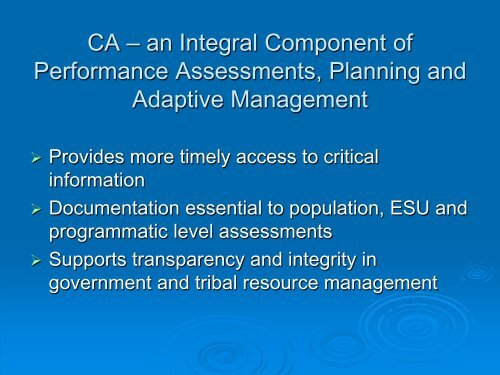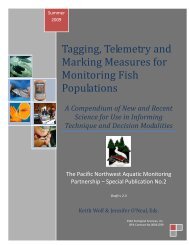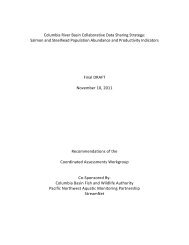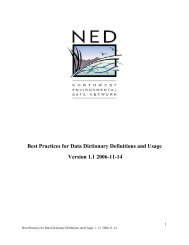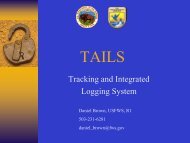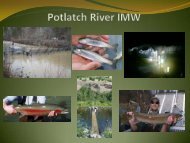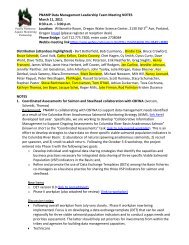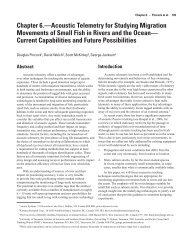Download this document
Download this document
Download this document
Create successful ePaper yourself
Turn your PDF publications into a flip-book with our unique Google optimized e-Paper software.
CA – an Integral Component of<br />
Performance Assessments, Planning and<br />
Adaptive Management<br />
‣ Provides more timely access to critical<br />
information<br />
‣ Documentation essential to population, ESU and<br />
programmatic level assessments<br />
‣ Supports transparency and integrity in<br />
government and tribal resource management
Key Management Questions<br />
• Are we meeting biological and programmatic performance<br />
objectives established within the Columbia Basin Fish and<br />
Wildlife Program, FCRPS BiOp and ESA Recovery Plans?<br />
• What factors are limiting our ability to achieve performance<br />
standards or objectives?<br />
• What is the effectiveness of different hydro and offsite<br />
mitigation actions in addressing these limiting factors?<br />
• Are actions being implemented and accomplished as<br />
proposed?<br />
• Is research and monitoring information accessible,<br />
adequately <strong>document</strong>ed, and compatible with regional<br />
standards and protocols for monitoring, data collection and<br />
access?
Strategies, Performance Measures and<br />
Adaptive Management Framework<br />
‣ Management Questions addressed through RM&E strategies and<br />
actions proposed in our FCRPS BiOp Proposed Action , the NOAA<br />
RPA and the subsequent AA Implementation Plans<br />
• Fish Population Status Monitoring<br />
• Hydro RM&E<br />
• Tributary Habitat RM&E<br />
• Estuary and Ocean RM&E<br />
• Harvest RM&E<br />
• Hatchery RM&E<br />
• Predation and Invasive Species Management RM&E<br />
• Coordination and Data Management<br />
• Project Implementation and Compliance Monitoring<br />
‣ Performance Tracking and Adaptive Management through<br />
Comprehensive Evaluations and Contingency Triggers
Proposals<br />
Contracting<br />
Protocol and Method Documentation<br />
Data Storage<br />
Data Sharing /Transfer
CA Products Critical to<br />
Performance Assessments<br />
‣ Status, Action Effectiveness, and Critical Uncertainty<br />
monitoring and research supports these assessments<br />
‣ Population and ESA level fish status and trends information<br />
relative to performance targets<br />
‣ H specific and population specific indicators such as, natural<br />
origin spawners, juvenile out-migrant abundance, adult per<br />
smolts out, smolts per adult back, and other life stage<br />
survival information.<br />
‣ Timely access and adequate <strong>document</strong>ation for assessments<br />
is critical.<br />
‣ CA fish indicator focused products will also support<br />
management of other H level data such as tributary and<br />
ocean habitat metrics.
BPA Data Management Plan Released to<br />
ISAB June 14 th for public comment:<br />
Focus on Seven Strategies<br />
1. Documentation of Management Questions into BPA<br />
system tools<br />
2. Documentation of Metadata: Protocols, methods, study<br />
plan metrics/indicators, location, people, etc.<br />
3. Data Collection Tools (handhelds and data entry forms)<br />
4. Data Entry (steward and QA/QC)<br />
5. Data Storage (Infrastructure)<br />
6. Data Transfer (exchange formats and web services)<br />
7. Analysis and Reporting (key reports and systems for<br />
regional consumption)
BPA’s<br />
Contributions<br />
to Data<br />
Management<br />
may Shift<br />
Based on<br />
Needs of<br />
Sponsors or<br />
Program
Metadata Documentation<br />
‣ Proper <strong>document</strong>ation of protocols and methods electronically<br />
takes the region forward to the next generation of science to<br />
support sharing, exchange of data.<br />
• Not Meeting RPA need to standardize Fish data collection<br />
methods:<br />
• For two years BPA has offered time and support to<br />
<strong>document</strong>s protocols in the www.monitoringmethods.org<br />
tools with little progress in the Fish community<br />
• Habitat has a PIBO, AREMP, CHaMP, EPA Macro-<br />
Inverts, and BPA/SRFB Habitat Action Effectiveness<br />
Protocols and methods <strong>document</strong>ed with standard data<br />
entry forms and exchange standards.
Metadata Documentation<br />
‣ BPA Approved Methods.<br />
• Fish Length<br />
• Habitat<br />
• SNPS Genetics
Metadata Documentation<br />
‣ Recent WDFW Meeting acknowledge state wide standards to<br />
be developed and <strong>document</strong>ed in mm.org<br />
‣ Eastern Oregon ODFW meeting result agreement of Biologist<br />
and data managers in need in need for standard to exchange<br />
common abundance term<br />
• Natural Origin Spawner Excluding Jacks = DET<br />
• Natural Origin Spawners = SPS<br />
• Adult Population Escapement = Oregon Explorer?<br />
• + Others<br />
‣ Agreement of team of BiOs and a data manager to work to<br />
<strong>document</strong> protocols/methods and standard field data entry<br />
forms to support Exchange format.
BPA BiOp Steelhead Monitoring<br />
Locations
BPA BiOp Funded Chinook Monitoring<br />
for Listed Stocks
Where do we go to look at all Species<br />
and all programs?<br />
‣ PNAMP: www.monitoringresources.org<br />
• Monitoring Site Manager and Explorer to help <strong>document</strong> locations<br />
‣ NOAA SPS (Only Listed Salmonid Species)<br />
‣ StreamNet<br />
• Primarily BPA Funded Salmonid Populations<br />
• Some Lower Snake Comp<br />
• Some State and Tribal<br />
• Some PUD<br />
‣ Resident Species?<br />
• KNRD Data base<br />
• StreamNet?<br />
‣ NPCC: The Council’s HLI Report (in Development and not west coast<br />
wide)
Example of Chinook Data and the need<br />
to Communicate Stories<br />
Based on SPS system outputs<br />
Natural-Origin Escapement
Issues with PIT Tag Data and Estimates<br />
of Adult Escapement as component of<br />
Natural Origin Spawners<br />
1. Documentation of study plan<br />
2. Out of population detections or<br />
straying into populations<br />
without detectors?<br />
3. Link of GIS and Genetics SNP<br />
for HO proportion based on<br />
Parental Based Tagging.<br />
4. Arrays not able to cover the<br />
full population’s distribution<br />
5. Comparison of PIT<br />
escapement to spawner<br />
abundance estimates<br />
6. Use of hatchery fraction<br />
7. Mark retention and mortality
Future Issue<br />
‣ Better location data to facilitate coordination<br />
• BPA Project Action Effectiveness may require “Juvenile<br />
Density” or “Adult Escapement” and does not want to<br />
duplicate effort between BPA and non BPA funded M&E<br />
‣ Limitation on ESA Take:<br />
• Proper planning to reduce take on populations below<br />
critical thresholds<br />
‣ Metadata <strong>document</strong>ation need to be complete<br />
‣ Completed reports (BPA executives have poor opinion of<br />
RM&E Reports and timeliness)<br />
‣ Provision of electronic data capture tools:<br />
• require standard method data entry forms<br />
• Managed under 1 BPA project to ensure cheep equipment<br />
‣ Data Sharing Agreements
The Funding of the CA<br />
‣ Commitments and financial support and how the CA work fits within<br />
the broader Data Management Strategy<br />
• What are the States, PUDs and NOAA providing to Match BPA<br />
funds, Status of EPA grant?<br />
• Additional funds to manage CA needs may come at the expense<br />
of existing monitoring and assessments that are not critical to<br />
BiOp implementation.<br />
• CRITFC contract to be in place in June 2013 to support NPT,<br />
WS, CTUIR and Yakama Tribes 2011 Appendix M request<br />
• StreamNet<br />
• FY 13 Support for Shoshone Bannock data strategy<br />
• FY 14 Funds planned for Colville<br />
• FY 14 States ask for additional funds beyond 2011 Appendix<br />
M working out how to address the need.
The Future of the CA<br />
‣ Progress on Fish abundance metrics needs to be demonstrated<br />
in SPS and StreamNet<br />
‣ Future Hatchery and resident species abundance indicators of<br />
interest to BPA management but success most be<br />
demonstrated.<br />
‣ Integration of CA approach in current Tributary Habitat Program


